University of Auckland
|
Te Whare Wānanga o Tāmaki Makaurau | |
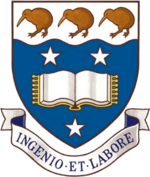 Coat of arms of the University of Auckland | |
| Motto | Latin: Ingenio et labore[1] |
|---|---|
Motto in English | By natural ability and hard work |
| Type | Public |
| Established | 1883; 135 years ago[1] |
| Chancellor | Scott St John[2] |
| Vice-Chancellor | Stuart McCutcheon |
Academic staff | 2,183 (FTE, 2015)[3] |
Administrative staff | 2,892 (FTE, 2015)[3] |
| Students | 33,050 (EFTS, 2015)[3] |
| Undergraduates | 25,754 (EFTS, 2015)[3] |
| Postgraduates | 7,717 (EFTS, 2015)[3] |
| Location | Auckland, New Zealand |
| Campus | Multiple |
| Affiliations | ACU, APAIE, APRU, Universitas 21, WUN |
| Website | www.auckland.ac.nz |
 | |

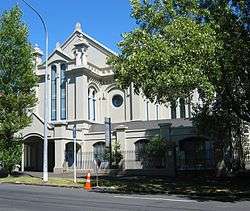
The University of Auckland (Māori: Te Whare Wānanga o Tāmaki Makaurau) is the largest university in New Zealand, located in the country's largest city, Auckland. It is the highest-ranked university in the country, being ranked 81st worldwide in the 2016/17 QS World University Rankings.[5] Established in 1883 as a constituent college of the University of New Zealand, the university is made up of eight faculties; these are spread over six campuses. It has more than 40,000 students, and more than 30,000 "equivalent full-time" students.[6]
History
The University of Auckland began as a constituent of the University of New Zealand, founded on 23 May 1883 as Auckland University College. Stewardship of the University during its establishment period was the responsibility of John Chapman Andrew (Vice Chancellor of the University of New Zealand 1885–1903). Housed in a disused courthouse and jail, it started out with 95 students and 4 teaching staff: Frederick Douglas Brown, professor of chemistry (London and Oxford); Algernon Phillips Withiel Thomas, professor of natural sciences (Oxford); Thomas George Tucker, professor of classics (Cambridge); and George Francis Walker, professor of mathematics (Cambridge). By 1901, student numbers had risen to 156; the majority of these students were training towards being law clerks or teachers and were enrolled part-time. From 1905 onwards, an increasing number of students enrolled in commerce studies.
The University conducted little research until the 1930s, when there was a spike in interest in academic research during the Depression. At this point, the college's executive council issued several resolutions in favour of academic freedom after the controversial dismissal of John Beaglehole (allegedly for a letter to a newspaper where he publicly defended the right of communists to distribute their literature), which helped encourage the college's growth.
In 1934, four new professors joined the college: Arthur Sewell (English), H.G. Forder (Mathematics), C.G. Cooper (Classics) and James Rutherford (History). The combination of new talent, and academic freedom saw Auckland University College flourish through to the 1950s.[1]
In 1950, the Elam School of Fine Arts was brought into the University of Auckland. Archie Fisher, who had been appointed principal of the Elam School of Fine Arts was instrumental in having it brought in the University of Auckland.
The University of New Zealand was dissolved in 1961 and the University of Auckland was empowered[7] by the University of Auckland Act 1961.
In 1966, lecturers Keith Sinclair and Bob Chapman established The University of Auckland Art Collection, beginning with the purchase of several paintings and drawings by Colin McCahon. The Collection is now managed by the Centre for Art Research, based at the Gus Fisher Gallery. The Stage A of the Science building was opened by Her Majesty Queen Elizabeth The Queen Mother on 3 May.
Queen Elizabeth II opened the new School of Medicine Building at Grafton on 24 March 1970. The Queen also opened the Liggins Institute in 2002.
In 1975-81 Marie Clay and Patricia Bergquist, the first two female professors, were appointed.[1]
The North Shore Campus, established in 2001, was located in the suburb of Takapuna. It offered the Bachelor of Business and Information Management degree. At the end of 2006, the campus was closed, and the degree relocated to the City campus.
On 1 September 2004, the Auckland College of Education merged with the University's School of Education (previously part of the Arts Faculty) to form the Faculty of Education. The faculty is based at the Epsom Campus of the former college, with an additional campus in Whangarei.
Professor Stuart McCutcheon became Vice-Chancellor on 1 January 2005. He was previously the Vice-Chancellor of Victoria University of Wellington. He succeeded Dr John Hood (PhD, Hon. LLD), who was appointed Vice-Chancellor of the University of Oxford.
The University opened a new business school building in 2007, following the completion of the Information Commons. It has recently gained international accreditations for all its programmes and now completes the "Triple Crown" (AMBA, EQUIS and AACSB).
In May 2013 the University purchased a site for new 5.2-hectare campus on a former Lion Breweries site adjacent to the major business area in Newmarket.[8] It will provide the University with a site for expansion over the next 50 years, with Engineering occupying the first of the new faculties in 2015.[1]
Fossil fuel divestment controversy
Unlike other prestigious New Zealand Universities such as the University of Otago and Victoria University of Wellington, the University of Auckland has not yet divested from fossil fuels. In April 2017, more than 100 students from the Auckland University Medical Students Association marched demanding the removal of coal, oil and gas from the University's investment portfolio. In May 2017, 14 people from student group Fossil Fuel UoA occupied the Clocktower, urging current Vice Chancellor Professor Stuart McCutcheon to issue a statement in support of divestment from fossil fuels. [9] After twelve hours, they were forcibly removed by police. The following day over two hundred students and staff marched to demand divestment from fossil fuels [10] and more than 240 members of staff from 8 faculties signed an open letter supporting divestment to the Boards of the University of Auckland Foundation and School of Medicine Foundation.[11] Professor McCutcheon has not yet indicated support for fossil fuel divestment.
Administration
The head of the University is the Chancellor, currently Scott St John,[2] however this position is only titular. The chief executive of the University is the Vice-Chancellor, currently Professor Stuart McCutcheon, who is the University's fifth Vice-Chancellor.[12]
Coat of arms
The Blazon of the Arms of the University of Auckland is: Azure between three mullets argent an open Book proper edged and bound Or with seven Clasps on either side Or, on a chief wavy also argent three Kiwis proper.[13][1] Translation of the Blazon. The shield is the first part described "Azure" means blue so the shield is blue. A "mullet" is a five pointed star and when there are three of them they are depicted two above and one below. Their colour is silver ("argent".) Between these stars is an open book and "proper" means the book is shown in its natural colours – normally black and white. The edge ("edged") of the book and the binding of the book is in gold ("Or".) and it is bound with seven clasps on either side which would close the book securely when closed. These clasps are also gold. A "chief" is a broad strip at the top of the shield but "wavy" means that the base of the chief is in a wave like line. The colour of the chief is silver ("argent".) On the chief are three kiwis and "proper" means that they are shown in their natural colour.
The university's motto is Ingenio et labore which may be translated from Latin as "By natural ability and hard work."[1]
Admission
Since eliminating open entry in 2009,[14] all applicants must have a university entrance qualification. Domestic students are required to achieve the NZQA University Entrance Standard,[15] while international students must achieve an equivalent approved qualification in their country.[16] Admission to the University also requires applicants to meet the preset academic and English language entry requirements specific to the degree for which they are applying.[17] Some programmes also have a preset number of places available within the degree. To be guaranteed entry students must achieve a rank score as well as meet any additional requirements.[18]
All students who did not complete their high school education or equivalent in English are also required to provide a valid IELTS score (minimum of 6.0) or equivalent.[19]
Campuses
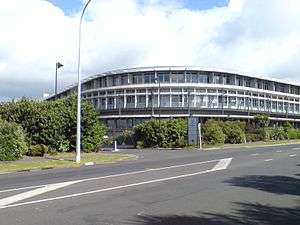
The University of Auckland has six campuses, five in Auckland and one in Whangarei in the Northland Region.
- The City Campus in the Auckland CBD has the majority of the students and faculties. It covers 16 hectares.[20]
- The Tāmaki Campus, established in 1991, covers 32 hectares in the suburb of Glen Innes,[20] 12 km from the City Campus. The degrees offered are in Health, Sports Science, Environmental Science, Wine Science, Information Technology, Communications and Electronics, Materials and Manufacturing, Food and Biotechnology and Information Management.
- The Grafton Campus, established in 1968, is opposite Auckland City Hospital in the suburb of Grafton, close to the City Campus. The Faculty of Medical and Health Sciences, School of Pharmacy and Department of Optometry are based here.
- The Epsom Campus is the main Faculty of Education campus, offering programmes in teacher education and social services. It was formerly the Auckland College of Education's main campus, until the college merged with the University's School of Education in September 2004 to form the Faculty of Education.
- Newmarket Campus. In 2010 Lion ceased operations at its Newmarket brewery, selling the site to the University in May 2013.[21] The university has built an engineering research space and a civil structures hall.
- The Tai Tokerau Campus in Whangarei offers Faculty of Education courses.
Other facilities include:
- The Leigh Marine Laboratory is effectively the marine campus and hosts postgraduate teaching and research at the Cape Rodney-Okakari Point Marine Reserve (Goat Island) near Warkworth. Situated on the east coast, about 100 km north of the city of Auckland, it has access to a wide range of unspoiled marine habitats.
- Some Faculty of Education courses are offered at Manukau Institute of Technology (MIT). Located in Otara, the Institute provides full amenities for students, including cafés, health services, a library, and limited parking.
In July 2011 Kim and Jeanette Goldwater gifted a 14-hectare winery in Waiheke Island to the University. This hosts the University's Wine Science courses.[22]
From the start of the first semester of 2010, the University banned smoking on any of its property, including inside and outside buildings in areas that were once designated as smoking areas.[23]
Faculties and institutes
Schools and faculties
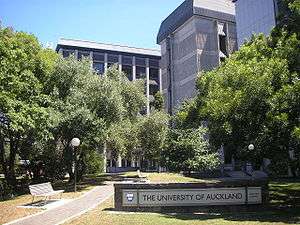
Research institutes
- The Liggins Institute
- Auckland Bioengineering Institute (ABI)
Academic staff
Until his death in 2009, the longest serving staff member was Emeritus Professor of Prehistory, Roger Curtis Green, BA BSc (New Mexico), PhD (Harv.), FRSNZ, MANAS. He had been on the staff 1961–66 and from 1973 onwards. The longest serving, non-'retired' staff member is Bernard Brown, ONZM, LLB (Hons) (Leeds), LLM (Sing.). He has been a full-time senior lecturer in the faculty of law 1962-65 and 1969 onwards. William Phillips, the influential economist largely famed for his Phillips curve, taught at the university from 1969 until his death in 1975. The programming language R, widely used by statisticians and data scientists, was developed at the university by Robert Gentleman and Ross Ihaka in the 1990s.
According to the Association of University Staff of New Zealand (AUS) in 2007, New Zealand universities, including the University of Auckland, had been taking a more litigious approach to managing their staff in recent years and engaged lawyers and employment advocates to handle even minor matters. The University of Auckland "paid out more than $780,000 in 2006 to settle problems it listed as including personal grievances and disputes".[32] For example, Paul Buchanan, a popular, world-renowned lecturer on international relations and security, was summarily dismissed in 2007 because a student to whom he sent an email complained that she found his comments about her performance in his class to be offensive.[33] He was later reinstated,[34] but this was just a formality[33] and he never returned to lecturing. As the AUS would not financially support a case for full reinstatement, Buchanan accepted the formal reinstatement and a nominal monetary payout as a settlement of his appeal to the Employment Court.[33]
Students
| Ethnicity of students[6] | 2017 | 2016 | 2015 | 2014 | 2013 |
|---|---|---|---|---|---|
| European | 15,587 - 36.8% | 16,095 - 38.4% | 16,771 - 39.8% | 17,372 - 41.4% | 17,451 - 42.2% |
| Asian | 17,607 - 41.6% | 16,683 - 39.8% | 16,219 - 38.5% | 15,769 - 37.6% | 15,291 - 37.0% |
| Pacific Islander | 3,620 - 8.6% | 3,609 - 8.6% | 3,582 - 8.5% | 3,531 - 8.4% | 3,277 - 7.9% |
| Māori | 3,116 - 7.4% | 3,183 - 7.6% | 3,183 - 7.6% | 2,932 - 7.0% | 2,882 - 7.0% |
| MELAA (Middle Eastern, Latin American, African) | 1,460 - 3.4% | 1,389 - 3.3% | 1,349 - 3.2% | 1,327 - 3.2% | 1,267 - 3.1% |
| Other | 912 - 2.2% | 907 - 2.2% | 996 - 2.4% | 1,022 - 2.4% | 1,195 - 2.9% |
| Total | 42,302 | 41,866 | 42,100 | 41,953 | 41,363 |
Auckland UniServices
Auckland UniServices Limited is the commercial research and knowledge transfer company for the university.[35]
Rankings
| University rankings | |
|---|---|
| Global | |
| ARWU World[36] | 201-300 |
| QS World[37] | 81 |
University rankings
The University of Auckland is New Zealand's leading university. It is the only one included in the Times Higher Education top 200 and it is the highest ranked New Zealand university in the QS World University Rankings and Shanghai Jiao Tong Academic Ranking of World Universities. Some 35 percent of the top ranked academic researchers in New Zealand are at the University of Auckland.
QS World University Rankings
2010 QS World University Rankings[38] ranked University of Auckland 68th overall in the world, scoring very consistently in the subject rankings: 51st in Arts & Humanities, 55th in Engineering & IT, 41st in Life Sciences & Biomedicine, 68th in Natural Sciences and 38th in Social Sciences.
2011 QS World University Rankings[39] ranked the University of Auckland 82nd overall in the world. In the subject rankings, it ranked less than the previous year: 55th in Arts & Humanities, 62nd in Engineering & IT, 50th in Life Sciences & Biomedicine, 73rd in Natural Sciences, 41st in Social Sciences and 33rd in Accounting & Finance.
2014 QS World University Rankings[40] ranked the University of Auckland 92nd overall in the world. In the subject rankings, it continues getting less than previous years for most areas: 91st in Natural Sciences, 66th in Engineering & IT, 74th in Life Sciences & Biomedicine, 30th in Social Sciences and 35th in Arts & Humanities.
2015 QS World University Rankings[41] ranked the University of Auckland 82nd overall in the world. In Faculty rankings, the University was placed 28th in Arts and Humanities, 34th in Social Sciences and Management, 59th in Engineering and Technology, 70th in Life Sciences and Medicine, and 134th in Natural Sciences.
2016 QS World University Rankings ranked the University of Auckland 81st overall in the world. The University of Auckland is ranked first in New Zealand in 35 of the 40 subjects, featuring in the top 50 in 15 subjects: Archaeology (20), Education (23), Development Studies (26), Psychology (29), English Language and Literature (31), Nursing (32), Law (32), Accounting and Finance (34), Geography (38), Civil and Structural Engineering (41), Architecture (44), Anthropology (44), Social Policy (49), Linguistics (49), Business and Management Studies (50).
PBRF rankings
The University of Auckland is a research-led university, and had the second highest ranking in the 2006 and 2012 Performance Based Research Fund (PBRF) exercises conducted by the government that evaluated the quality of researchers and research output of all tertiary institutions in New Zealand.
In the previous PBRF evaluation in 2003, when the University was ranked the top research university in New Zealand, the Commission commented: "On virtually any measure, the University of Auckland is the country’s leading research university. Not only did it achieve the highest quality score of any TEO [tertiary education organisation], but it also has by far the largest share of A-rated researchers in the country."[42]
Accommodation
The University provides a range of accommodation options for students. Several hundred live in Residential Halls and Apartments, which provide, respectively, food, accommodation, social and welfare services, alongside self-catered, private residences. Ongoing expansion of accommodation facilities will see 2780 students housed in University residences from Semester One 2016.[43]
The university ceased leasing Railway Campus in November 2008.[44]
Construction work started in 2015 on a 343-bed studio apartment complex on the corner of Symonds and Airdale Streets, set for completion on 2017. A further 800 catered beds are currently being planned and are expected to be completed by 2019.[43]
Students' association
The Auckland University Students' Association (AUSA) represents students at the University. AUSA publicises student issues, administers student facilities, and assists affiliated student clubs and societies. AUSA also produces the student magazine Craccum and runs the radio station bFM. The name of the alumni association is the University of Auckland Society.
CECIL
CECIL (CSL, short for Computer Supported Learning) was the university's learning management and course management system before Canvas and was developed in-house. It had more than 44,000 log-ins per day (2008 April). Cecil support staff worked with academics on research into cheating detections during online assessment,[45] productivity improvement using a learning management system (LMS),[46] and effectiveness of tools in LMS.[47] Cecil contains many of the features of similar systems such as Sakai Project and WebCT. Cecil also provides interactive tools for collaboration and other tools specific to the University.[48] In 2014, a review of learning and teaching technology was initiated, seeking to replace Cecil. The review determined that Canvas (a learning management system developed by Instructure) would be implemented prior to the commencement of the 2016 academic year, and CECIL now acts as an archive for old courses.[49]
Notable alumni
Academia
- Rom Harré, Oxford philosopher
- Harry Hawthorn, Canadian anthropologist
- John Hood, former Vice-Chancellor of the University of Oxford
- Charlotte Macdonald, historian
- Diane M. Mackie, social psychologist
- Susan Moller Okin, philosopher
- Peter C. B. Phillips, economist
- Elizabeth Rata, professor of education
- Graham Smith, academic
- Rory Sweetman, historian
- Ronald Syme, pre-eminent New Zealand classicist of the 20th century
- Rorden Wilkinson, political economist
- David Wills, translator of Jacques Derrida
Arts
- Cheryll Sotheran, founder of the Museum of New Zealand Te Papa Tongarewa
Business
- Vincent Cheng, chairman of HSBC
- Shayne Elliott (born 1963/64), New Zealand banker
- Paul Huljich, CEO of Best Corporation, author
- Jane Taylor, chair of New Zealand Post and Landcare Research
Film and television
- Philippa Boyens, Academy Award-winning screenwriter
- Niki Caro, film director, producer and screenwriter.
- Jacqueline Feather, screenwriter
- Lucy Lawless, actress
- Christine Tan, CNBC news anchor
Music
- Marcus Chang, Taiwanese singer-songwriter & actor
- Gary Chaw, singer-songwriter
- Gareth Farr, composer
- Tim Finn, musician
- Jeffrey Grice, pianist
- Ashley Lawrence, conductor
- Marya Martin, flautist
- Shirley Setia, singer-songwriter youtuber
- Wilma Smith, Fijian-born concert violinist and music teacher
Politics and law
- Jan Beagle, Under-Secretary-General of the United Nations
- Helen Clark, former Prime Minister of New Zealand, former Administrator of the United Nations Development Programme
- Colin Craig, businessman and leader of the Conservative Party of New Zealand
- Sian Elias, New Zealand Chief Justice since 17 May 1999
- Jeanette Fitzsimons, New Zealand politician and environmentalist
- Lowell Goddard, Judge[50]
- Jonathan Hunt, former Speaker of the House of Representatives, Order of New Zealand
- Sir Kenneth James Keith, New Zealand Judge appointed to the International Court of Justice
- David Lange, former Prime Minister of New Zealand
- Viliami Latu, Tongan Minister of Police
- Tuilaepa Aiono Sailele Malielegaoi, Prime Minister of Samoa
- Leslie Munro, former New Zealand's permanent representative to the United Nations, former President of the Trusteeship Council, former President of the United Nations General Assembly, three times President of the Security Council
- Winston Peters, politician and leader of the NZ First party
- Anthony Randerson, New Zealand Chief High Court Judge from December 2004 to February 2010. Now a Judge of the New Zealand Court of Appeal
- Mike Rann, former Premier of South Australia, and future Australian High Commissioner to the United Kingdom
- Anand Satyanand, former Governor General, New Zealand
- Peter Thomson, Fijian diplomat, Fiji's former Permanent Representative to the United Nations, former President of the General Assembly of the United Nations
- Taufa Vakatale, former Deputy Prime Minister of Fiji
- Vangelis Vitalis, diplomat
Science and technology
- Sir Vaughan Jones, Fields medallist
- Sir Harold Marshall, acoustician and architect
- Stephen Parke, physicist
- William Sage Rapson, chemist
- Daniel Frank Walls, physicist
- Crispin Gardiner, physicist
- Howard Carmichael, physicist
- Ross Ihaka, statistician
- Penelope Brothers, chemist
Sports
- Jo Aleh (born 1986), sailor, national champion, world champion, and Olympic champion
- Russell Coutts (born 1962), yachtsman
- Mahé Drysdale (born 1978), Australian-born New Zealand rower
- Gavin Hastings (born 1962), Scottish rugby player
- Michael Jones (born 1965), rugby player and coach
- Jerome Kaino (born 1983), American Samoan-born New Zealand rugby player
- Jean Spencer (born 1940), United Kingdom-born New Zealand Olympic gymnast
- Eliza McCartney (born 1996), New Zealand Olympic pole vaulter
References
- 1 2 3 4 5 6 7 "Our history: Key developments 1883-2000s". The University of Auckland. Retrieved April 18, 2018.
- 1 2 "Officers of the University". University Calendar. The University of Auckland. Retrieved 18 April 2018.
- 1 2 3 4 5 "Annual Report 2015" (PDF). Retrieved 25 March 2017.
- ↑ Heritage Sites to Visit: Auckland City. Heritage New Zealand. Retrieved 6 November 2008.
- ↑ "QS World University Rankings 2016". 25 August 2016. Retrieved 18 April 2018.
- 1 2 "Annual Report 2017" (PDF). The University of Auckland. p. 9. Retrieved 20 July 2018.
- ↑ McLintock, A.H., ed. (1966). "Education, University – University of New Zealand". An Encyclopaedia of New Zealand. Retrieved 10 December 2013.
- ↑ Gibson, Anne (January 21, 2014). "Rebuild of old Lion Breweries site underway for university". NZ Herald. Retrieved April 18, 2018.
- ↑ "Students occupy University of Auckland, demanding divestment from fossil fuels". Stuff. Retrieved 18 April 2018.
- ↑ "Hundreds of students, staff march for divestment". Scoop News. Retrieved 18 April 2018.
- ↑ "Staff Open Letter to the UoA Foundation". Retrieved 18 April 2018.
- ↑ "Uni. of Auckland Management". Archived from the original on 10 February 2013. Retrieved 17 December 2012.
- ↑ "Arms of the University of Auckland". University Calendar. The University of Auckland. Retrieved April 18, 2018.
- ↑ "Shutting The University Doors – Students Say NO". Scoop News. Retrieved 17 June 2015.
- ↑ "National Certificate of Educational Achievement (NCEA) Level 3 – The University of Auckland". www.auckland.ac.nz. Retrieved 17 June 2015.
- ↑ "Minimum overseas entry requirements – The University of Auckland". www.auckland.ac.nz. Retrieved 17 June 2015.
- ↑ "General information about entry requirements". The University of Auckland. Retrieved 20 July 2009.
- ↑ "National Certificate of Educational Achievement (NCEA) Level 3 – The University of Auckland". www.auckland.ac.nz. Retrieved 17 June 2015.
- ↑ "English language requirements". The University of Auckland. Retrieved 20 July 2009.
- 1 2 "Faculties, institutes and campuses". The University of Auckland. Retrieved 28 April 2012.
- ↑ "Auckland Uni confirms brewery site buy". 3 News. 23 April 2013.
- ↑ Alcock, Gil (20 July 2011). "Goldwaters' gift to uni". stuff.co.nz. Retrieved 31 January 2012.
- ↑ "Auckland Uni begins the year smoke free". 3 News. 1 March 2010.
- ↑ Faculty of Arts. The University of Auckland. Retrieved on 6 November 2008.
- ↑ Faculty of Business and Economics. The University of Auckland. Retrieved on 6 November 2008.
- ↑ Creative Arts and Industries. The University of Auckland. Retrieved on 18 November 2016.
- ↑ Faculty of Education and Social Work. The University of Auckland. Retrieved on 1 April 2015.
- ↑ Faculty of Engineering. The University of Auckland. Retrieved on 6 November 2008.
- ↑ Faculty of Law. The University of Auckland. Retrieved on 6 November 2008.
- ↑ Faculty of Medical and Health Sciences. The University of Auckland. Retrieved on 6 November 2008.
- ↑ Faculty of Science. The University of Auckland. Retrieved on 6 November 2008.
- ↑ "AUS tertiary update". Scoop News. Association of University Staff of New Zealand. 11 October 2007. Retrieved 28 April 2012.
- 1 2 3 "Paul Buchanan's employment at Auckland Uni ends". Scoop News. 28 September 2010. Retrieved 28 April 2012.
- ↑ Gay, Edward (20 September 2008). "Sacked lecturer reinstated". The New Zealand Herald. Retrieved 1 February 2012.
- ↑ Auckland UniServices Archived 15 February 2012 at the Wayback Machine.. Auckland UniServices Limited. Retrieved on 18 July 2009.
- ↑ "ARWU World University Rankings 2017 - Academic Ranking of World Universities 2017 - Top 500 universities - 2017". Shanghai Ranking. Retrieved 18 April 2018.
- ↑ "QS World University Rankings 2018". 5 June 2017. Retrieved 18 April 2018.
- ↑ "QS World University Rankings 2010 Results".
- ↑ QS World University Rankings 2015/16. Top Universities. Retrieved on 1 October 2015.
- ↑ "QS World University Rankings (2014/15)". QS Quacquarelli Symonds Limited. 2014. Retrieved 21 September 2014.
- ↑ "QS World University Rankings (2015/16)". QS Quacquarelli Symonds Limited. 2015. Retrieved 19 September 2015.
- ↑ "Full report" (PDF). Archived from the original (PDF) on 14 October 2008. Retrieved 23 August 2008. (174 KB)
- 1 2 "600 more beds at University of Auckland - The University of Auckland". www.auckland.ac.nz. Retrieved 2015-11-22.
- ↑ Gibson, Anne (7 November 2008). "Uni quits Railway Campus over repairs". The New Zealand Herald. Retrieved 25 November 2011.
- ↑ Detecting Cheaters using a Learning Management System. Cecil. Retrieved 6 November 2008.
- ↑ Increasing Teaching Productivity with EuropeMMM. Cecil. Retrieved 6 November 2008.
- ↑ On-Line Course Surveys: Do Incentives Work. Ed/ITLib Digital Library, AACE. Retrieved 6 November 2008.
- ↑ Cecil Training. Cecil. 6 November 2008.
- ↑ "University improvements - The University of Auckland". www.auckland.ac.nz. Retrieved 2015-11-22.
- ↑ "Profile: Justice Lowell Goddard". BBC. 4 February 2015. Retrieved 4 February 2015.
- A Complete Guide To Heraldry by A.C. Fox-Davies 1909.
External links
| Wikimedia Commons has media related to University of Auckland. |
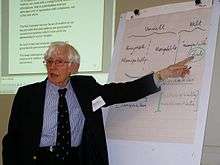


.jpg)
.jpg)
.jpg)